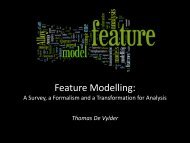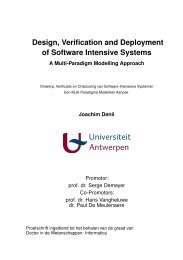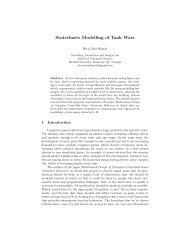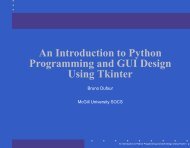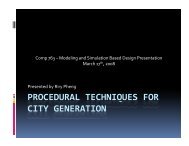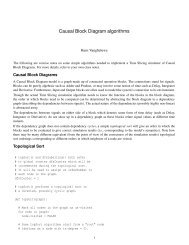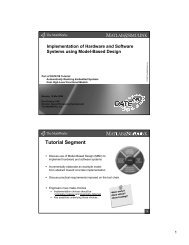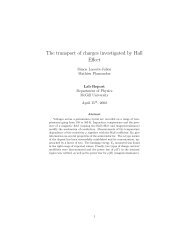Object-oriented framework for modelling and ... - ResearchGate
Object-oriented framework for modelling and ... - ResearchGate
Object-oriented framework for modelling and ... - ResearchGate
Create successful ePaper yourself
Turn your PDF publications into a flip-book with our unique Google optimized e-Paper software.
5.2 Coupling of world model <strong>and</strong> data l<strong>and</strong>scape<br />
Lets now focus on the coupling of the World model <strong>and</strong> data l<strong>and</strong>scape. The World object can be con-<br />
sidered as the object container possessing all entities in the simulation <strong>and</strong> being coupled with the data<br />
l<strong>and</strong>scape. In large propagation phenomena, the latter is generally provided by a GIS. This case can be<br />
h<strong>and</strong>led easily by means of the Experimental frame (Vasconcelos et al., 1995). The relevant issues we<br />
retain are: the number of active <strong>and</strong> passive cells, the spatial environment dimension <strong>and</strong> its scale of rep-<br />
resentation, the velocity per<strong>for</strong>mance <strong>and</strong> the memory capacity required.<br />
Spatial-<strong>oriented</strong> structure<br />
E<br />
D<br />
A<br />
C<br />
B<br />
Entity-<strong>oriented</strong> structure<br />
A<br />
B<br />
C<br />
D<br />
E<br />
Position (2,4)<br />
Position (4,7)<br />
Position (6,6)<br />
Position (5,3)<br />
Position (3,1)<br />
Figure 10: Choices of world data structure <strong>for</strong> DES<br />
In accordance with these issues, two basic approaches can be retained to encapsulate <strong>and</strong> to<br />
manipulate the world data structure (Campos <strong>and</strong> Hill, 1998) (Fig. 10). The first is spatial-<strong>oriented</strong> <strong>and</strong><br />
the second is entity-<strong>oriented</strong>. In a spatial-<strong>oriented</strong> approach we can see the world like a grid providing a<br />
matrix of positions where a position can be assigned to an entity. This approach is suitable <strong>for</strong> simula-<br />
tions with a large number of entities <strong>and</strong> where the computer time per<strong>for</strong>mance is more important than<br />
memory constraints. The second approach is <strong>for</strong> simulations with few simulation entities <strong>and</strong> when we<br />
do not want to use the large memory space required by a spatial localisation table (matrix of positions).<br />
Thus, localisation in<strong>for</strong>mation is saved inside the entity instead of having a matrix of position where a<br />
position points to the entity. As a consequence, little memory space will be lost in the simulation imple-<br />
22




